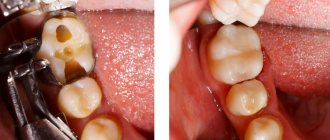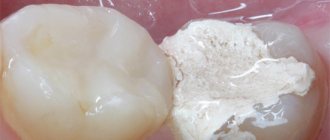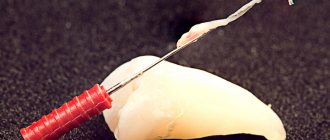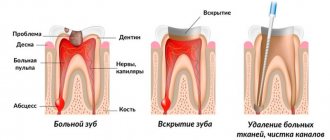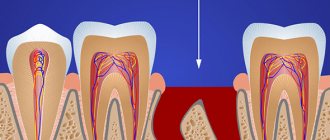Content
hide
1 Pulp - structure, functions, features
2 Why is a tooth without pulp considered dead?
3 How long does a tooth live without pulp?
4 What can lead to the need to remove a “dead” tooth: 4.1 There are several rules by adhering to which patients can prolong the use of the tooth:
Inflammation of the “nerve” of the tooth (pulpitis) is not always accompanied by severe toothache. A chronic infectious process can occur in a tooth unnoticed, leading to significant tooth destruction, the formation of a cyst on the root of the tooth, and even tooth loss. This pathology is an indication for tooth depulpation—removal of its “nerve.” Sometimes such news can come as a surprise to a patient if he did not suspect the presence of chronic pulpitis. At the same time, we are often asked - what will happen to the tooth later, after pulp removal? How long will the tooth live after this procedure, how will its condition change? We'll talk about this in the article.
Pulp - structure, functions, features
The pulp is also called the dental nerve. This is a soft connective tissue that contains a collection of nerve fibers, lymphatic and blood vessels. It is located in the tooth cavity (pulp chamber of the crown part of the tooth and in the root canals). Along the edge of the pulp there are cells, the processes of which are immersed in the dentin of the tooth. Thus, the pulp is closely connected with the hard tissues of the tooth. Through these connections, the trophic function is carried out; the pulp “nourishes” the walls of the tooth. Pain and mechanical sensitivity are also provided by the processes of pulp cells.
The blood supply to each tooth is provided by the common arteries and veins of the maxillofacial area. Small capillaries extend from them and enter the pulp, feeding the tooth. This structure protects the tooth from inflammation, proliferation of pathogens and other pathological processes.
The rich blood supply to the tooth also causes pain during inflammation. When the pulp becomes infected, a massive rush of blood occurs to its capillaries to provide a protective reaction, and swelling occurs inside the tooth. Enlarged vessels and soft tissues compress the nerve endings of the pulp, causing pain.
How to remove a nerve from a tooth - video, stages
Removal of the tooth nerve is a classic method of treating pulpitis. Its essence lies in the following steps:
- drilling out all tissues affected by caries (Fig. 2),
- removal of dental pulp (carried out using a special instrument),
- mechanical expansion of channels (Fig. 3),
- filling of tooth root canals (Fig. 4),
- filling the coronal part of the cube (Fig. 5).
Treatment of pulpitis: stages of tooth depulpation
Below we will describe in more detail each stage of treatment for pulpitis; perhaps this information will help you identify a would-be dentist and prevent poor-quality treatment and its complications.
Why is a tooth without pulp considered dead?
The main thing that changes in the condition of the tooth after depulpation is that the trophism (nutrition) of the hard tissues is lost, the tooth becomes very fragile and reacts sharply to external factors.
The absence of nerve endings affects the protective function of the tooth: in the absence of a pain reaction, a person can damage the tooth by biting something hard on it and not notice it. The pulp ceases to protect the tooth from microbes, as a result of which it becomes more susceptible to caries.
As you can see, a pulpless tooth requires additional care, as it is more vulnerable than healthy ones.
Content:
- In what cases may depulpation be required?
- How the procedure goes:
- How long does a tooth hurt after nerve removal?
2.1. Basic techniques.
3.1. Indications for a repeat visit to the dental clinic.
Many will agree with the statement that going to the dentist can hardly be called a pleasant pastime. Sometimes specialists are faced with panic fear even before the banal treatment of uncomplicated caries, not to mention situations when the patient is indicated for depulpation - removal of a nerve. Modern technologies have made this procedure completely painless and safe, but even an experienced and qualified doctor cannot completely eliminate the possibility of complications. And sometimes the patient complains of pain in the tooth after removal of the nerve. Is this normal or should I immediately contact a specialist?
How long does a tooth live without pulp?
This period varies greatly. In some patients, the tooth is destroyed within a year, and in others it can last for another ten years. What's the difference? Here are the factors that affect the condition of the tooth after depulpation:
- the degree of initial destruction of the crown of the tooth;
- pulp removal technique, quality of root canal filling;
- the method by which the tooth was restored after removal of the nerve (filling/inlay/crown);
- caring for the tooth after treatment, performing the necessary hygiene procedures.
After the tooth is depulped, treatment procedures are required that will improve its vitality. First of all, this is filling. Empty root canals are filled with special material. Complete and high-quality removal of the entire pulp, as well as hermetically filling the canals with filling material over the entire length, reduces the risk of inflammation of the tissues surrounding the tooth and the appearance of a cyst.
Depending on the degree of tooth decay and the specific clinical situation, the doctor may suggest restoring the tooth with either a filling, a ceramic inlay, or an artificial crown. An inlay and a crown are the optimal methods for restoring “dead” teeth, because they cover the tooth from above and fit hermetically to the tooth, thereby reducing the contact of the internal environment of the tooth with bacteria in the oral cavity, moisture and air, and protecting the tooth from chips and cracks. In addition, it is comfortable for the patient and has an aesthetic appearance.
Should a tooth hurt after nerve removal?
I would like to say right away that pain after depulpation is normal. As a rule, after surgery there is some exacerbation of inflammatory processes, the cause of which is surgical intervention on dental tissues. Yes, formally, tooth depulpation refers to an operation, since work is done with the neurovascular bundle of the tooth - the nerve (pulp). In this case, pain can occur under various influences: pressing, pressing or biting.
Usually, to eliminate post-filling symptoms, the patient is prescribed non-steroidal anti-inflammatory drugs, for example, ibuprofen or paracetamol. They help relieve pain and make life easier
What can lead to the need to remove a “dead” tooth:
- damage to the tooth root by caries;
- the occurrence of longitudinal fractures and root cracks (below the gum level);
- the presence of a cyst or granuloma on the root of the tooth, inflammation of the tissues surrounding the tooth, the treatment of which is not possible.
There are several rules that patients can follow to prolong the life of their teeth:
- cover the tooth with a ceramic inlay or crown;
- visit the dentist once every 6 months for a check-up, hygienic cleaning and, if necessary, a control X-ray of the tooth;
- do not chew hard food (nuts, seeds, crackers, etc.);
- Avoid temperature changes when eating (for example, hot coffee with cold ice cream).
As we see, a patient can do a lot for his health. But in order for the tooth to last longer, it is much more important to choose a specialized clinic that uses modern technologies, high-quality equipment and materials. An experienced and knowledgeable doctor will ensure the vital activity of a pulpless tooth for a long time.
How long does a tooth hurt after nerve removal?
As a rule, pain when pressed or any other impact persists for 7-10 days. This manifestation is considered a normal postoperative reaction of the body.
If the pain does not go away over time and even increases, then you should immediately consult a doctor. Prolonged pain may be caused by
- Unidentified root canals in which pulp is preserved.
- Insufficient mechanical or chemical cleaning of the canals, which is why part of the pulp remains in it or an infection has developed.
- Getting antiseptic or foreign objects into the gums.
- Damage to the gums.
- Presence of infection.
- Incorrectly performed procedure.
- Presence of a tool fragment in the channel, etc.
If, after depulpation, increased sensitivity to cold and hot additionally appears, this indicates that during the operation only part of the pulp was removed and the inflammatory process itself has not yet been stopped.
In addition, the reason why it is painful to press on the tooth after nerve removal may be a problem with the filling itself. Some people experience allergic reactions to the material or the shape of the filling is simply not adjusted correctly to the bite. This problem can easily be eliminated by grinding off the filling or replacing it with another one.
Acute pain in the area of the upper jaw teeth, which appears only after a certain period of calm, is a sign of possible odontogenic sinusitis. This is an inflammation of the maxillary sinuses, which appears due to an infection located in the roots. The problem is solved through the joint efforts of an ENT specialist and a dentist. If you contact a specialist in a timely manner, the course of treatment takes a minimum of time and passes without complications.
How does the procedure work?
The time has long passed when the dentist had to perform treatment almost blindly. Now all modern clinics have portable X-rays, many have a computed tomography machine, and the doctor can get a complete picture of the condition of the patient’s oral cavity in a matter of minutes.
To avoid serious complications, the most common of which is tooth pain after nerve removal, an X-ray or tomogram (panoramic or of a strictly defined area) must be taken before depulping. Only in this way can the dentist assess:
- severity of the pathological process;
- length and shape of the dental canal;
- changes in the structure of the periodontium (connective tissue surrounding the roots);
- condition of neighboring dental units: with lateral caries, sometimes when one tooth is depulped, it is easier to immediately fill the neighboring ones.
Basic techniques
Currently, doctors use one of the following methods of therapy:
- Vital. Most often used. All manipulations are carried out during one patient visit: using special devices, the dentist completely cleans the canals, after which the cavity is sealed. More often they put a permanent filling, sometimes (usually when treating chronic, advanced inflammation) a temporary filling, which after 3-5 days, if there is no pain in the tooth after removing the nerve, it is replaced with a regular one.
- Devital. A special paste is first placed into the canals, which causes necrosis of the pulp tissue. In addition to the devitalizing component, such medications also contain antiseptics, so the drug additionally has a disinfecting effect. Previously, pastes containing arsenic were used for this purpose; now modern, completely safe medicines are used. The prepared cavity is sealed with temporary filling material for several days. During the second visit, the devitalized tissue is removed, the canals are filled and the crown is restored with photopolymer materials.
